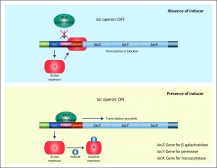replica plating
(Science: technique) technique for testing the genetic characteristics of bacterial colonies. A dilute suspension of bacteria is first spread, in a petri dish, on agar containing a medium expected to support the growth of all bacteria, the master plate. Each bacterial cell in the suspension is expected to give rise to a colony. A sterile velvet pad, the same size as the petri dish, is then pressed onto it, picking up a sample of each colony. The bacteria can then be stamped onto new sterile petri dishes, plates, in the identical arrangement. The media in the new plates can be made up to lack specific nutritional requirements or to contain antibiotics. Thus colonies can be identified that cannot grow without specific nutrients or that are antibiotic resistant and cells with mutations in particular genes can be isolated.
Dictionary > Replica plating
You will also like...

Gene Action – Operon Hypothesis
Learn how the way genes control and determine every aspect of the body. This lesson uses lac operon as an example. ..
..

Insects
There are more species of insects than any other species combined. This surely illustrates that insects have the selecti..

Mammalian Ancestors
Mammals are a diverse group of organisms, where most of them develop their offspring within the uterus of the mother. Ov..

Movement of Molecules Across Cell Membranes
Molecules move within the cell or from one cell to another through different strategies. Transport may be in the form of..

Protein Synthesis
Part of the genetic information is devoted to the synthesis of proteins. mRNA, a type of RNA, is produced as a transcri..

Meiosis and Alternation of Generations
Plants are characterized by having alternation of generations in their life cycles. This tutorial is a review of plant m..

